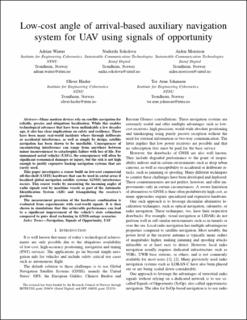| dc.contributor.author | Winter, Adrian | |
| dc.contributor.author | Sokolova, Nadezda | |
| dc.contributor.author | Morrison, Aiden J | |
| dc.contributor.author | Hasler, Oliver Kevin | |
| dc.contributor.author | Johansen, Tor Arne | |
| dc.date.accessioned | 2023-12-20T09:07:02Z | |
| dc.date.available | 2023-12-20T09:07:02Z | |
| dc.date.created | 2023-06-01T15:14:16Z | |
| dc.date.issued | 2023 | |
| dc.identifier.citation | IEEE - ION Position Location and Navigation Symposium. 2023, (C3: Signals of Opportunity-Based Systems), 1162-1169. | en_US |
| dc.identifier.issn | 2153-358X | |
| dc.identifier.uri | https://hdl.handle.net/11250/3108339 | |
| dc.description.abstract | Many modern devices rely on satellite navigation for reliable, precise and ubiquitous localization. While this enables technological advances that have been unthinkable a few decades ago, it also has clear implications on safety and resilience. There have been many real-world incidents where through deliberate or accidental interference, as well as simply by design, satellite navigation has been shown to be unreliable. Consequences of encountering interference can range from anywhere between minor inconveniences to catastrophic failure with loss of life. For unmanned aerial vehicles (UAVs), the consequences will often be significant economical damages or injury, but the risk is not high enough to justify expensive backup navigation systems that are rarely used. This paper investigates a sensor build on low-cost commercial off-the-shelf (COTS) hardware that can be used in costal areas if localized global navigation satellite systems (GNSS) interference occurs. This sensor works by measuring the incoming angles of radio signals sent by maritime vessels as part of the Automatic Identification System (AIS) and triangulating the receiver’s position. The measurement precision of the hardware combination is evaluated from experiments with real-world signals. It is then shown in simulations that this achievable performance can lead to a significant improvement of the vehicle’s state estimation compared to pure dead reckoning in GNSS-outage scenarios. | en_US |
| dc.description.abstract | Low-Cost Angle of Arrival-Based Auxiliary Navigation System for UAV using Signals of Opportunity | en_US |
| dc.language.iso | eng | en_US |
| dc.publisher | IEEE | en_US |
| dc.rights | Navngivelse 4.0 Internasjonal | * |
| dc.rights.uri | http://creativecommons.org/licenses/by/4.0/deed.no | * |
| dc.subject | Navigasjon | en_US |
| dc.subject | Navigation | en_US |
| dc.title | Low-Cost Angle of Arrival-Based Auxiliary Navigation System for UAV using Signals of Opportunity | en_US |
| dc.title.alternative | Low-Cost Angle of Arrival-Based Auxiliary Navigation System for UAV using Signals of Opportunity | en_US |
| dc.type | Peer reviewed | en_US |
| dc.type | Journal article | en_US |
| dc.description.version | acceptedVersion | en_US |
| dc.subject.nsi | VDP::Informasjons- og kommunikasjonsteknologi: 550 | en_US |
| dc.subject.nsi | VDP::Information and communication technology: 550 | en_US |
| dc.source.pagenumber | 1162-1169 | en_US |
| dc.source.journal | IEEE - ION Position Location and Navigation Symposium | en_US |
| dc.source.issue | C3: Signals of Opportunity-Based Systems | en_US |
| dc.identifier.doi | 10.1109/PLANS53410.2023.10139950 | |
| dc.identifier.cristin | 2150928 | |
| dc.relation.project | Norges forskningsråd: 288634 | en_US |
| cristin.ispublished | true | |
| cristin.fulltext | postprint | |
| cristin.qualitycode | 1 | |

